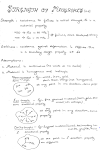Aggregates
Introduction
- In the construction industry, aggregates are used as filler material in the production of concrete and mortar.
- Aggregates occupy around 70 to 80 per cent of the volume of the construction, reduce shrinkage effects and minimize costs.
- The coarse aggregates form the main matrix of concrete and the fine aggregates form the filler matrix between the coarse aggregates.
Classification of Aggregate:
A) Based on Geological Origin:
On the basis of origin, aggregates can be classified into natural aggregates and artificial aggregates.i) Natural Aggregates:-
The aggregates which are obtained by crushing igneous, sedimentary or metamorphic rocks are called natural aggregates. Aggregates obtained from igneous rocks have the best engineering properties, hence they are the most widely used aggregates.
ii) Artificial Aggregates:-
The aggregates which are obtained from man-made processes are called artificial aggregates. Surkhi (powdered broken brick), Blast furnace slag aggregates and synthetic aggregates are some of the examples of artificial aggregates.
B) Based on Size:
According to size, aggregates can be classified as coarse aggregates and fine aggregates.
i) Coarse aggregates:-
The aggregates which pass through the 80mm sieve and are retained on the 4.75mm sieve are called as coarse aggregates.ii) Fine Aggregates:-
All the aggregates which pass through the 4.75mm sieve are called as fine aggregates. on the basis of particle size distribution, the fine aggregates are classified into four zones (i.e.) Zone 1 to 4. The grading zones are progressively finer from grading Zone 1 to grading Zone 4.c) Based on Shape:
Based on the shape of the aggregates, they are classified as rounded, irregular, angular and flaky.
i)Rounded Aggregate:
ii) Irregular Aggregate:
These aggregates are irregular in shape and require more cement paste compared to rounded aggregates. Because of the irregularity in shape, these aggregates form a good interlocking bond and are suitable in the production of concrete.
iii)Angular Aggregate:
These aggregates are sharp, have an angular shape and rough texture. These aggregates are best suited for the preparation of high strength concrete.
iv) Flaky Aggregate:
The aggregates whose thickness is less than 0.6 times the mean dimension are called as flaky Aggregates.
v)Elongated Aggregates:
The aggregates whose length is 1.8 times the mean dimension are called as Elongated Aggregates.
Testing of Coarse Aggregates:
A) Shape and Size Test:
The shape and size of aggregates can be determined by the Flakiness Index and Elongation Index Tests.
Flakiness Index Test:
Flakiness Index is defined as the ratio of the weight of aggregates whose least dimension (thickness)
is less than 0.6 times of their mean dimension to the weight of the sample taken.
F.I=(( weight of aggregates whose least dimension is less than 0.6 times of their mean dimension)/(weight of the sample taken)) x 100
A minimum of 200 pieces of aggregates must be taken for testing.
Elongation Index Test:
Elongation index test must be performed only on non-flaky aggregates.
Elongation index is defined as the ratio of weight of aggregates whose greatest dimension(length) is greater than 1.8 times of their mean dimension to the weight of the sample taken,
E.I=((weight of aggregates whose greatest dimension(length) is greater than 1.8 times of their mean dimension)/(weight of the sample taken)) x 100
Both F.I and E.I must be less than or equal to 30%
B) Strength Test:
The strength of aggregate is assessed based on three parameters:i) Aggregate Crushing Value (ACV)
ii) Aggregate Impact Value (AIV)
iii) Aggregate Abrasion Value (AAV)
i) Aggregate Crushing Strength Test:-
- This test gives the Aggregate Crushing Value (ACV), Which is an Index of crushing strength.
- The apparatus used for this test is Compression Testing Machine (or) Universal Testing Machine.
- A sample of aggregates, in a surface dry condition, which passes through the 12.5mm sieve and is retained on 10mm sieve are taken for this test (W1).
- A load of 400 KN is applied gradually on the sample of aggregates for 10 minutes.
- The sample is now sieved on a 2.36 mm sieve and the fraction passing through the sieve is weighed (W2).
- Aggregate Crushing Value (AVC)=(W2/W1) x 100.
ii) Aggregate Impact Value Test:-
- This test gives the Aggregate Impact Value (AIV), which is an index of the resistance of aggregates to sudden shock or impact.
- The apparatus used for this test is called Impact Testing Machine.
- A sample of aggregates, in a surface dry condition, which passes through the 12.5 mm sieve and is retained on 10mm sieve are taken for this test (W1).
- The whole sample is compacted in three layers with 25 blows each time.
- Now the hammer of the Impact Testing Machine is raised until its lower face is 380mm above the upper surface of the aggregate sample and allowed to fall freely.
- The test sample is subjected to a total of 15 blows, each being delivered at an interval of not less than one second.
- The sample is now sieved on a 2.36 mm sieve and the fraction passing through the sieve is weighed (W2).
- Aggregate Impact Value (AIV)=(W2/W1) x 100.
iii) Aggregate Abrasion Value Test:-
The Aggregate Abrasion Value of Coarse aggregates may be determined by either Deval Machine (or) by Los Angeles Machine.Using Deval Machine:-
- The test specimen of the aggregates is weighed (W1 Kg) before transferring it to the machine along with Abrasive charge.
- Now, this sample is placed in the drum of the machine inclined at 300 to the horizontal and is allowed to rotate @ 2000 revolutions per hour for 5 hours.
- After 5 hours, the aggregates are sieved on a 1.70 mm IS sieve (As per IS:2386 Part IV) and the retained aggregates are weighed (say W2 Kg).
- Loss in Weight as percentage indicates the percentage of wear.
- Aggregate Abrasion Value (AAV)=(W2/W1) X 100.
Using Los Angeles Abrasion Testing Machine:-
- The test specimen of aggregates is weighed (W1 Kg) before transferring it to the machine along with Abrasion charge.
- Now, this sample is placed in the cylinder of the machine which is allowed to rotate @ 20 to 33 rpm for a total of 500 revolutions.
- After 500 revolutions, the aggregates are seived on a 1.70 mm IS sieve (As per IS:2386 part IV) and the retained aggregates are weighed (say W2 Kg).
- Loss in weight as percentage indicates the percentage of wear.
- Aggregate Abrasion Value (AAV)=(W2/W1) x 100.
iv) Soundness Test:-
- This test is used to assess the durability of aggregates.
- It is a cyclic procedure of alternate wetting and drying.
- sodium sulphate (Na2So4) Solution (or) Magnesium Sulphate (MgSo4) solution is used for wetting.
- After 10 cycles of alternate wetting and drying, % loss of weight is observed.
- It should be less than 12% if wetting is done using Na2So4 Solution.
- It should be less than 18% if wetting is done using MgSo4 Solution.
Testing of Fine Aggregates:-
i) Fineness Modulus Test:-
- Fineness Modulus is an index of Fineness of Aggregates.
- Sieve analysis is performed on the given fine aggregates.
- Fineness Modulus = (Sum Cumulative % retained on each sieve)/100
| <2.2 | Very fine sand |
|---|---|
| 2.2-2.6 | Fine Sand |
| 22.6-2.9 | Medium Sand |
| 2.9-3.2 | Coarse Sand |
ii) Bulking Test:-
- The increase in the volume of sand due to the presence of free moisture in it is called as bulking of sand.
- This free moisture forms a thin film over the sand particles which keeps the neighbouring particles away due to the effects of surface tension, Thus resulting in bulking of the volume of the sand.
- The significance of surface tension forces and consequently how far the sand particles are pushed away will depend on the percentage of moisture present and also the size of the fine aggregate particles.
- Generally, this phenomenon occurs in all sizes of aggregates, but it is significant mostly in fine sands and coarse slits.
- It is also to be noted that the effects of bulking increases with an increase in moisture up to a certain limit further increase in moisture content leads to a decrease in the bulking effects. No bulking can be observed when the sand is completely saturated.
- To estimate the extent of bulking of sand, a sample of moist fine aggregate is filled into a measuring cylinder till the fine aggregate is completely inundated. Since the fine aggregate is completely saturated, there are no bulking effects. Now, its level is noted down as h2. Now the percentage bulking can be calculated using the following formula.
% Bulking = ((h1-h2)/h2) x 100
Alkali-Aggregate Reaction:
Alkali-Aggregate reaction which occurs over time in concrete between the highly alkaline cement paste and non-crystalline silicon dioxide, which is found in many common aggregates. This reaction can cause expansion, leading to spalling and loss of strength of concrete.Grading of Aggregates:
- Grading is a process of determining particle size distribution.
- One of the most important factors for producing workable concrete is good grading of aggregates.
- Continuously graded aggregate is the grading pattern of aggregate in which all particle sizes of certain proportions are present.
- Gap Graded aggregate is the grading pattern of aggregate in which there are combinations of certain large size aggregates and certain small size aggregates ( which is equal to the size of voids formed by the large size aggregates).






0 Comments